Finnish Hockey History primer, part 1
I can't believe this is actually done. I can't thank 
thefourthvine enough, for taking my jumbled second-language English and making something sensible out of it. None of this would make nearly as much sense as it does, if it wasn't for you. I really and truly could not have asked for a better beta.
Also, as a heads-up: this here is a very word heavy, possibly somewhat overly long primer. If you're just looking for a picspam, I'm sad to say that you're in the wrong place. Hopefully, it's still enjoyable regardless.
With that being said, let's get to it
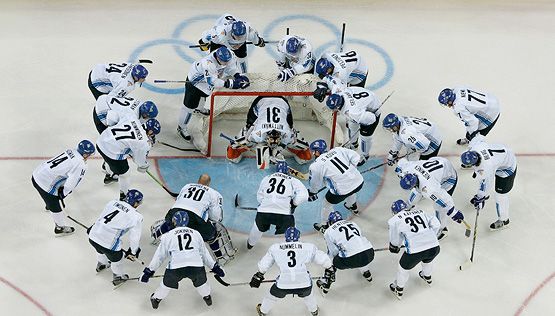
Starting with the basics.
Hockey in Finland, then and now:
Ice hockey, and especially international hockey, is kind of huge in Finland. The first game in Finland was played in 1899 and since then it has come to the most popular sport played here and very much a part of our national identity. Personally I don't know a single Finn who doesn't know how to skate at least a little, or who hasn't seen a single game either live or on TV. There are 14 teams playing in SM-Liiga, our top professional league, which is considered to be amongst the strongest in the world. According to Finnish Ice Hockey Association the overall number of teams is just shy of 3k, and more than 40k games are played during the season. The number of registered players, around 61k, is little over 1.0% of the population. Finland is one of the "Big Six" of international hockey. Successful hockey players are pretty much regarded as national heroes.
But by no means has this always been the case.
The 1920s and '30s: Start of a beautiful rivalry
In 1928 Finland played it's first international game. It was a friendship game played in Helsinki, the capital of Finland, against our dear neighbors- the Swedes. Finland lost 8-1. Well, at least we were able to score one goal, right? A rematch the following day resulted in another loss, 3-1 this time.
A year later the Finnish Ice Hockey Association, the governing body of Finnish hockey, was founded, with 17 clubs as members at the time.
The next time Finland played internationally wasn't until 1933: another friendship match against the Swedes, played in Stockholm, Sweden this time. The two day games went to Sweden yet again, with scores of 11-1 and 6-0.
And then four years later, in 1937, Finland played against Estonia for the first time, and won the game 2-1. The first ever international victory for Finland. The next year's games didn't go as well, as Finland lost to Sweden yet again (3-1). The second meeting between Finland and Estonia ended 2-1 again, but this time in Estonia's favor, and the first meeting between Finland and Romania ended in 6-6 tie.
But then 1939 rolled around and with it Finland's first time playing in the World Championships. Playing against Germany, Italy, the USA, and the Netherlands, Finland scored only 5 goals in the whole tournament and lost every single game it played, placing last.So by this time, it had been pretty firmly established that the Swedes just could not be beaten, as we had gone against them seven times and lost every single time. What with Finland having been unable to so much as score twice in the same game the overall numbers were 37-5.
1940s: Victory is possible
So the start of the '40s wasn't actually such a great time in finnish hockey history. But seeing as there was a war going on, I think we can be forgiven. During the years '41-'45, Finland played five games, twice against Switzerland and three times against Sweden, and lost every single game.
But from then, things started to look just a little bit less bleak. For one thing in 1946, for the first time we were able to score more than once in single game against Sweden; that year's friendship game ended with a score of 9-5 for Sweden.It was also during this time that the first Finn managed to get in to the NHL. Technically there had been one, Albert Pudas, as early as '26, but as he'd been a Canadian citizen from the age of 18 months he doesn't usually get credited. (Although, as a fun fact, the guy was born in 1899, the same year as the first ever Finnish hockey game.)
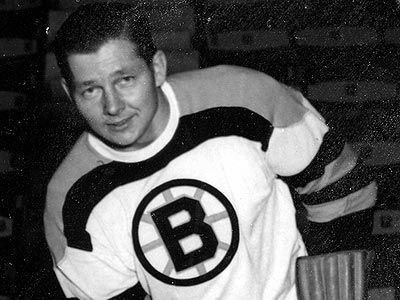
During his time in NHL Lund played for the Boston Bruins and New York Rangers
During the '48-'49 season Pentti Lund became the first Finnish born player to score in a NHL game - Pudas played only four games during his career, and never recorded any points. Lund went on to win the Calder Memorial Trophy and came close to being the first Finnish born Stanley Cup -winner. Unfortunately Lund never played in Finland as he'd moved to Canada at the age of six.
Mean while, back in Finland, the year '49 came and with it the second time Finland played in the World Championships. By that time, Finland had played nearly twice the number of international games as during the '30s (23 games by the end of the championships) and hadn't even lost every one of them. Mostly because we had started playing against Norway, who clearly sucked even more than we did. Something had gone right in any case, and so, Finland managed to get it's first wins in a championship tournament, against Norway and Belgium.
Also in '49, Finland played against Canada for the first time, in a friendship game in Helsinki held just few days before Worlds. The game ended 5-4 for Canada, but at least we managed to make it a pretty even match.
And in 1948 the Finnish coat of arms was used in the players' jerseys for the first time. Over the years it has become part of the team's identity so much that in Finland the national team is called Leijonat, the Finnish word for lions, in every possible non-official connection.
So we went from this:
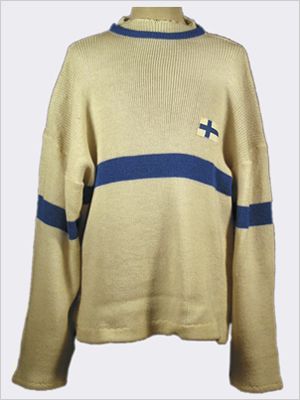
To this:
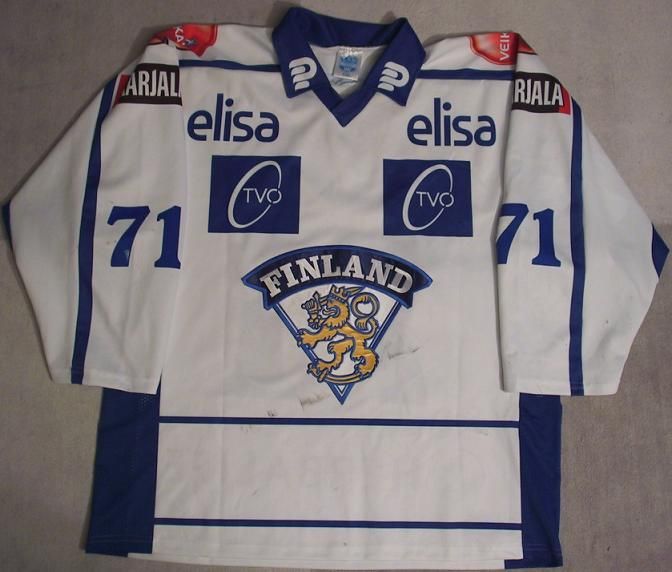
The '50s: First time for everything
The '50s really we're a decade of firsts for Finnish hockey. Starting in 1952, Finland played in the Winter Olympics for the first time, and didn't even suck ass nearly as much as we could've. Out of the nine countries playing Finland placed in seventh ahead of Germany and Norway. During this decade, Finland played at Worlds seven times, a record number so far.
In 1954 Finland went up against the Soviets first during friendship game celebrating the 25-year old Finnish Ice Hockey Association, and then at Worlds that year, losing first 8-1 and then 7-1. It was first time that our national teams had played against each others. Also at Worlds that year, Finland had its most humiliating defeat so far, when Canada beat us 20-1. But the worst was yet to come. During the '58 Championships, again playing against Canada, Finland recorded its biggest loss up to present date 24-0. 1958 was a pretty bad year all around. Even Norway managed to beat us for the first time.
One important milestone was reached in 1956 when the first ever outdoor-rink was built in Tampere. Finland is generally really cold country with long winters, that can last from as mid-November to end of April , especially in the Northern parts. So it wasn't much of a problem to just ice tennis fields and the like in the winter. And also, 10% of our area is water, so you could always find lakes or ponds on which to skate.
Because of how readily available indormal rinks were, it wasn't before hockey started really gaining popularity that building rinks became necessary.
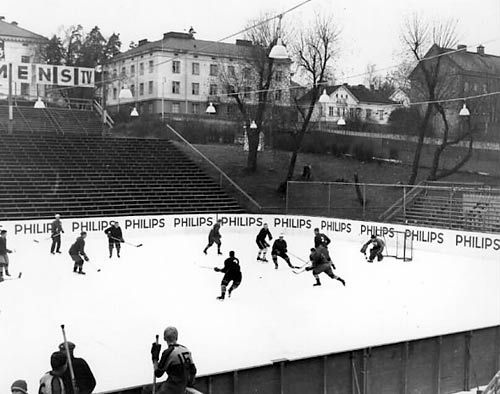
The very first outdoor-rink. It had a huge impact on the development of Finnish hockey, as it enabled longer seasons and improved practice and playing opportunities. Today, the rink is open to the public and used mostly by nearby schools.
Another big step was taken in '59 when Finland got it's first foreign head coach, Canadian Joe Wirkkunen. Wirkkunen had worked as an assistant coach during the -51-52 season. This was clearly the right call, because during Worlds that year Finland managed to tie against Sweden, for the first time in history.
The 60's: Finland hosts Worlds and starts winning for real, on occasion at least
This could arguably be called the time when Finland stated it's slow rise to join the big names of hockey. For the first time, Finland participated in all the World Championships, including three Olympic Games.
In -65 the country's first indoor rink was built in Tampere and Finland hosted Worlds for the first time. Although Finland placed seventh of the eight countries playing, mostly the games are remembered in Finland for the 2-2 tie against Sweden, which was celebrated as pretty much a victory at the time.
The hero of the game was Matti 'Mölli' Keinonen, who scored both of Finland's goals in the game against Sweden. The game sparked such a frenzy in Finnish people that a couple of days after the tournament he got kissed on the neck by a complete stranger in the middle of the central Tampere, whilst the guy was sober no less. Keep in mind than Finnish people are sometimes considered to be such introverts that they don't even look strangers in the eyes unless absolutely necessary.

Unfortunately I wasn't able to find a picture of him in the '71 games, so here one from '69 instead. Keinonen is the one cheering with his face to the camera.
The tournament was a big success for Finland all around, including financially, and is considered to be an important milestone in the rise of hockey's popularity.
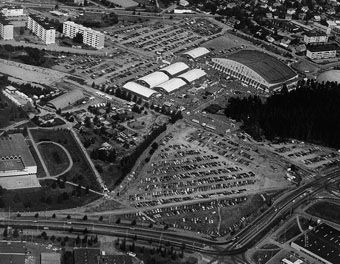
The rink in itself was also a huge deal. Here's the oldest picture of it that I could find. The rink - often called ”Hakametsän jäähalli” (Hakametsä Ice Hall) after the district it's located - is in the upper right corner.
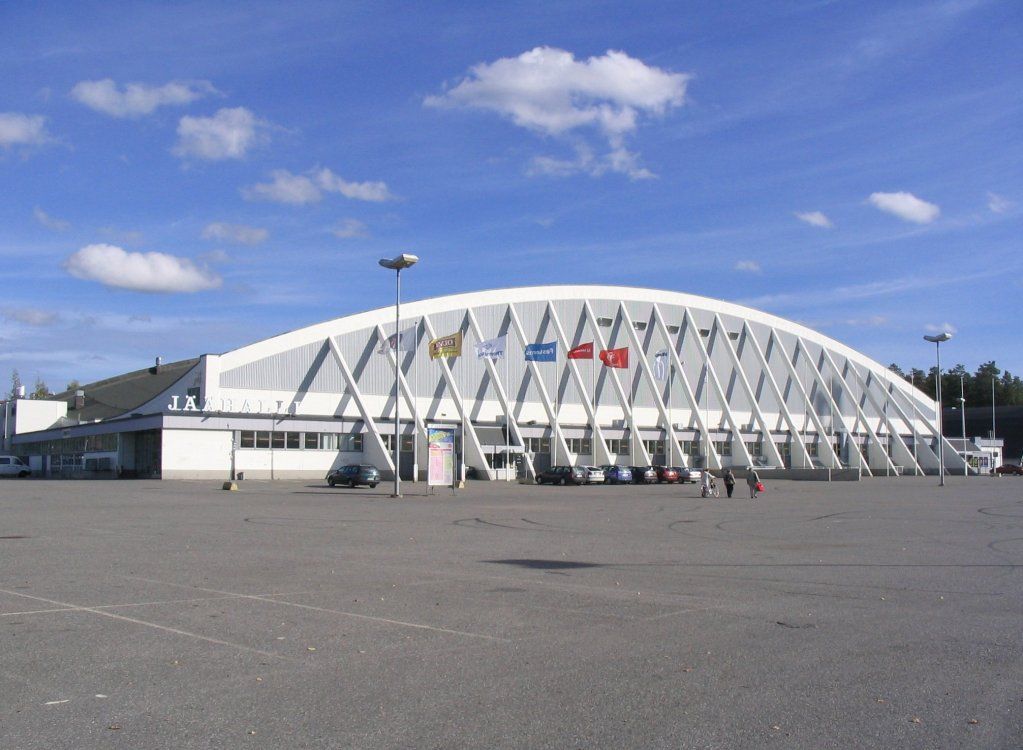
And here's what the outside of the rink looks like today. The latest remodeling was done during the summer of '09. It's the home-arena of two SM-Liiga teams.
Two years later, Finland got its first championship tournament victory from one of the big hockey countries when we beat Czechoslovakia 3-1. The next big victory was a year later in the Olympics, when we beat Canada 5-2.
Now if only we'd been able to win against the Swedes. . .
The 70's: Those goddamn bloody Swedes, and doping-trouble
So it's 1970. Finnish hockey is slowly picking up speed. Maybe it might even be possible for us to win a medal one of these days. Sweden hosts the World Championships and lo and behold, for the first time ever, Finland actually manages to beat them. 3-1! In their home arena! Finally. The only way to go is up, right? Right.
The joy from that victory lasted just until the next year's Championships. Once again, Finland was playing against Sweden, only this time if they won, it would mean the first ever championship medal for Finland. With just two minutes on the clock, Finland was leading the game 1-0. And then it happened. A Swedish defenseman made a lazy shot from the blue line. The puck hit a Finnish skate and changed direction just so. Goal and bronze for Sweden, nothing for Finland. The long and oh-so-painful list of if- only moments in our hockey history starts.
In '74 Finland finally got its first medal: silver in the Under 20 Championships (U20 later on). Finland also hosted the men's championships for the second time, in Helsinki this time. Going in to the games, Finland had its "best team ever", and getting a medal was practically a forgone conclusion. Especially our goalies were praised to the high heavens.
The games got off to kind of a bad start, when a Swedish forward tested positive for ephedrine. He claimed it was because of cough syrup, but Sweden still lost points from it's game against Poland. Finland swore up and down that such a thing could never happen to our team. I can just imagine the glee that Finnish hockey fans must have felt at the time.
The games went amazingly well for Finland, and after a 5-2 win against Czechoslovakia, Finland had finally earned it's first ever World Championship bronze.
That is, until our starting goalie, Stig Wetzell, got selected for a doping test, and tested positive for, yes you guessed it, ephedrine.
Naturally Wetzell claimed complete innocence, with the whole team backing him up. The whole thing went so far as to start conspiracy theories. Amongst the explanations for the results we're eating gum and bananas. Nevertheless Finland's victory got reversed in favor of the Czechs, costing Finland the medal once again.
There was also a theory that the team's previous doctor who was in charge of the dopingtesting in the tournament was getting revenge for having been fired just before the tournament began. Nothing has ever been proven though, and in all likelihood this is just a nasty rumor started by Wetzell himself.
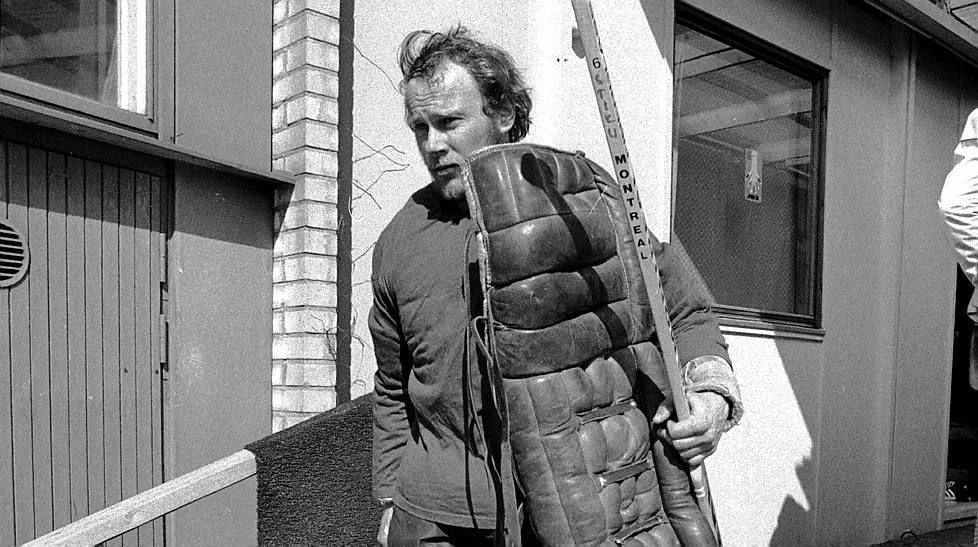
The facts still stand; this guy costs us our first championship bronze. He's one of the most debated figures in Finnish hockey history today, partly due to the absolution given to him by FIHA in 2003, when he was accepted into the Finnish Hockey Hall of Fame, for reasons unknown for most Finns. It's not like it's ever been proven that his results were false.
In any case, the tournament wasn't over yet, and Finland still had a theoretical chance at a medal. Unfortunately, we didn't really have a goalie anymore. Wetzell had naturally been shut out of the tournament, and our backup goalie had been injured. So then our back-up back-up got called in, and took a puck to the head during the first practice he was on the ice. Despite having to get stitched he nevertheless finished playing the tournament for Finland. And because the situation wasn't absurd enough, the rules said that there had be a back-up goalie listed in the starting line-up. Which we didn't have. So every player not in the actual line-up got named. And to put the whole thing on the side of hilarious, one guy got tasked with standing at the edge of the rink with a bucket full of pucks which he was to through on the ice all at once, if our goalie seemed to be in too much trouble. To my knowledge he didn't end up having to do say. Not that it matter in the end, since Finland still wasn't able to get a medal in the end.
Althrough the rest of the '70s hockey in Finland continued to grow. A big development was the founding of SM-Liiga in 1975; although only semi-professional in its early days, this paved the way for professional hockey in Finland. There still weren't a lot of players making a living off of just hockey and it was a common practice especially among young players, to accept contracts without wages. Finland had to wait two more decades for an all-professional league, as it wasn't until the mid-90s, that all players in SM-Liiga were pros.
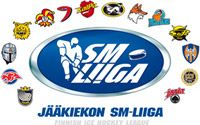
The league logo, with all the club logos

The above is clearly proof, that everything was uglier during the '90s, which is when that version of the logo was in use. I'm not exactly sure how long that version was in use, but I think it was from late '80s to mid '90s.
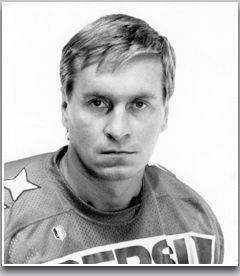
Finnish pro-hockey history was being made elsewhere also. During the 1976-'77, season Matti Hagman (picture above) became the first player who'd trained and started his career in Finland, to make it to NHL. Hagman played a season and a half with the Boston Bruins, and even got play in the Stanley Cup -Finals.
For team Finland, rest of the '70s were somewhat so so. The great chase of a championship medal continued, but with still no results. During the Winter Olympics in Innsbruck 1976, we had high hopes. Canada and Sweden were both a no-show. It was now or never!
And so we continue with our list of if- only moments. During a game against the US, Soviet-referee Victor Dombrovsk put himself on Finnish hockey fans shitlist. With a score of 4-5 in favor of the US, and with just a minute left on the clock, Finland was trying to tie the game with an empty net. And - miracle! The puck bounced off the chest of a Finnish player and into the goal. Was our luck finally changing?
Of course not. Dombrovsk's completely and totally wrong call was that the puck was kicked in and thus the goal nullified. If we sometimes feel that the refs are plotting against us, is just because they are. Surely this is proof enough of that.
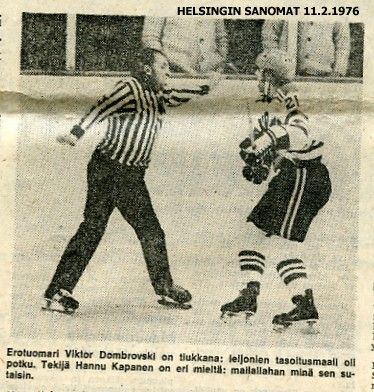
Despite the loss Finland was still third in points, having beat West-Germany. When the West Germany vs. USA game went to West Germany, all three countries were tied with four points each. What followed was a bunch of mathematical moves that can't possibly be followed without a PhD in What the Actual Fucking Hell. Finlands goal difference in the whole tournament was +1 against W-Germanys -3 and USAs -6.
Finlands final placement? Fourth. Instead of overall tournament goal difference, the decision was based on goal difference in games played between the three tied countries. And no, Finland didn't even lose that one either. We tied with West Germany. And so then the target ratio of goals was counted. Finland's was 1.12 and West Germany's 1.16.
The absolute worst of the worst was that only thing we would've needed to do in order to get to third place would have been to score one more goal against either team. Oh, right. We did!
So by now, if nothing else, Finnish hockey fans had grown pretty familiar with the feeling of bitter disappointment. Considering what was yet to come, that was probably a good thing. But more on that in the next part.

thefourthvine enough, for taking my jumbled second-language English and making something sensible out of it. None of this would make nearly as much sense as it does, if it wasn't for you. I really and truly could not have asked for a better beta.
Also, as a heads-up: this here is a very word heavy, possibly somewhat overly long primer. If you're just looking for a picspam, I'm sad to say that you're in the wrong place. Hopefully, it's still enjoyable regardless.
With that being said, let's get to it

Starting with the basics.
Hockey in Finland, then and now:
Ice hockey, and especially international hockey, is kind of huge in Finland. The first game in Finland was played in 1899 and since then it has come to the most popular sport played here and very much a part of our national identity. Personally I don't know a single Finn who doesn't know how to skate at least a little, or who hasn't seen a single game either live or on TV. There are 14 teams playing in SM-Liiga, our top professional league, which is considered to be amongst the strongest in the world. According to Finnish Ice Hockey Association the overall number of teams is just shy of 3k, and more than 40k games are played during the season. The number of registered players, around 61k, is little over 1.0% of the population. Finland is one of the "Big Six" of international hockey. Successful hockey players are pretty much regarded as national heroes.
But by no means has this always been the case.
The 1920s and '30s: Start of a beautiful rivalry
In 1928 Finland played it's first international game. It was a friendship game played in Helsinki, the capital of Finland, against our dear neighbors- the Swedes. Finland lost 8-1. Well, at least we were able to score one goal, right? A rematch the following day resulted in another loss, 3-1 this time.
A year later the Finnish Ice Hockey Association, the governing body of Finnish hockey, was founded, with 17 clubs as members at the time.
The next time Finland played internationally wasn't until 1933: another friendship match against the Swedes, played in Stockholm, Sweden this time. The two day games went to Sweden yet again, with scores of 11-1 and 6-0.
And then four years later, in 1937, Finland played against Estonia for the first time, and won the game 2-1. The first ever international victory for Finland. The next year's games didn't go as well, as Finland lost to Sweden yet again (3-1). The second meeting between Finland and Estonia ended 2-1 again, but this time in Estonia's favor, and the first meeting between Finland and Romania ended in 6-6 tie.
But then 1939 rolled around and with it Finland's first time playing in the World Championships. Playing against Germany, Italy, the USA, and the Netherlands, Finland scored only 5 goals in the whole tournament and lost every single game it played, placing last.So by this time, it had been pretty firmly established that the Swedes just could not be beaten, as we had gone against them seven times and lost every single time. What with Finland having been unable to so much as score twice in the same game the overall numbers were 37-5.
1940s: Victory is possible
So the start of the '40s wasn't actually such a great time in finnish hockey history. But seeing as there was a war going on, I think we can be forgiven. During the years '41-'45, Finland played five games, twice against Switzerland and three times against Sweden, and lost every single game.
But from then, things started to look just a little bit less bleak. For one thing in 1946, for the first time we were able to score more than once in single game against Sweden; that year's friendship game ended with a score of 9-5 for Sweden.It was also during this time that the first Finn managed to get in to the NHL. Technically there had been one, Albert Pudas, as early as '26, but as he'd been a Canadian citizen from the age of 18 months he doesn't usually get credited. (Although, as a fun fact, the guy was born in 1899, the same year as the first ever Finnish hockey game.)

During his time in NHL Lund played for the Boston Bruins and New York Rangers
During the '48-'49 season Pentti Lund became the first Finnish born player to score in a NHL game - Pudas played only four games during his career, and never recorded any points. Lund went on to win the Calder Memorial Trophy and came close to being the first Finnish born Stanley Cup -winner. Unfortunately Lund never played in Finland as he'd moved to Canada at the age of six.
Mean while, back in Finland, the year '49 came and with it the second time Finland played in the World Championships. By that time, Finland had played nearly twice the number of international games as during the '30s (23 games by the end of the championships) and hadn't even lost every one of them. Mostly because we had started playing against Norway, who clearly sucked even more than we did. Something had gone right in any case, and so, Finland managed to get it's first wins in a championship tournament, against Norway and Belgium.
Also in '49, Finland played against Canada for the first time, in a friendship game in Helsinki held just few days before Worlds. The game ended 5-4 for Canada, but at least we managed to make it a pretty even match.
And in 1948 the Finnish coat of arms was used in the players' jerseys for the first time. Over the years it has become part of the team's identity so much that in Finland the national team is called Leijonat, the Finnish word for lions, in every possible non-official connection.
So we went from this:

To this:

The '50s: First time for everything
The '50s really we're a decade of firsts for Finnish hockey. Starting in 1952, Finland played in the Winter Olympics for the first time, and didn't even suck ass nearly as much as we could've. Out of the nine countries playing Finland placed in seventh ahead of Germany and Norway. During this decade, Finland played at Worlds seven times, a record number so far.
In 1954 Finland went up against the Soviets first during friendship game celebrating the 25-year old Finnish Ice Hockey Association, and then at Worlds that year, losing first 8-1 and then 7-1. It was first time that our national teams had played against each others. Also at Worlds that year, Finland had its most humiliating defeat so far, when Canada beat us 20-1. But the worst was yet to come. During the '58 Championships, again playing against Canada, Finland recorded its biggest loss up to present date 24-0. 1958 was a pretty bad year all around. Even Norway managed to beat us for the first time.
One important milestone was reached in 1956 when the first ever outdoor-rink was built in Tampere. Finland is generally really cold country with long winters, that can last from as mid-November to end of April , especially in the Northern parts. So it wasn't much of a problem to just ice tennis fields and the like in the winter. And also, 10% of our area is water, so you could always find lakes or ponds on which to skate.
Because of how readily available indormal rinks were, it wasn't before hockey started really gaining popularity that building rinks became necessary.

The very first outdoor-rink. It had a huge impact on the development of Finnish hockey, as it enabled longer seasons and improved practice and playing opportunities. Today, the rink is open to the public and used mostly by nearby schools.
Another big step was taken in '59 when Finland got it's first foreign head coach, Canadian Joe Wirkkunen. Wirkkunen had worked as an assistant coach during the -51-52 season. This was clearly the right call, because during Worlds that year Finland managed to tie against Sweden, for the first time in history.
The 60's: Finland hosts Worlds and starts winning for real, on occasion at least
This could arguably be called the time when Finland stated it's slow rise to join the big names of hockey. For the first time, Finland participated in all the World Championships, including three Olympic Games.
In -65 the country's first indoor rink was built in Tampere and Finland hosted Worlds for the first time. Although Finland placed seventh of the eight countries playing, mostly the games are remembered in Finland for the 2-2 tie against Sweden, which was celebrated as pretty much a victory at the time.
The hero of the game was Matti 'Mölli' Keinonen, who scored both of Finland's goals in the game against Sweden. The game sparked such a frenzy in Finnish people that a couple of days after the tournament he got kissed on the neck by a complete stranger in the middle of the central Tampere, whilst the guy was sober no less. Keep in mind than Finnish people are sometimes considered to be such introverts that they don't even look strangers in the eyes unless absolutely necessary.

Unfortunately I wasn't able to find a picture of him in the '71 games, so here one from '69 instead. Keinonen is the one cheering with his face to the camera.
The tournament was a big success for Finland all around, including financially, and is considered to be an important milestone in the rise of hockey's popularity.

The rink in itself was also a huge deal. Here's the oldest picture of it that I could find. The rink - often called ”Hakametsän jäähalli” (Hakametsä Ice Hall) after the district it's located - is in the upper right corner.

And here's what the outside of the rink looks like today. The latest remodeling was done during the summer of '09. It's the home-arena of two SM-Liiga teams.
Two years later, Finland got its first championship tournament victory from one of the big hockey countries when we beat Czechoslovakia 3-1. The next big victory was a year later in the Olympics, when we beat Canada 5-2.
Now if only we'd been able to win against the Swedes. . .
The 70's: Those goddamn bloody Swedes, and doping-trouble
So it's 1970. Finnish hockey is slowly picking up speed. Maybe it might even be possible for us to win a medal one of these days. Sweden hosts the World Championships and lo and behold, for the first time ever, Finland actually manages to beat them. 3-1! In their home arena! Finally. The only way to go is up, right? Right.
The joy from that victory lasted just until the next year's Championships. Once again, Finland was playing against Sweden, only this time if they won, it would mean the first ever championship medal for Finland. With just two minutes on the clock, Finland was leading the game 1-0. And then it happened. A Swedish defenseman made a lazy shot from the blue line. The puck hit a Finnish skate and changed direction just so. Goal and bronze for Sweden, nothing for Finland. The long and oh-so-painful list of if- only moments in our hockey history starts.
In '74 Finland finally got its first medal: silver in the Under 20 Championships (U20 later on). Finland also hosted the men's championships for the second time, in Helsinki this time. Going in to the games, Finland had its "best team ever", and getting a medal was practically a forgone conclusion. Especially our goalies were praised to the high heavens.
The games got off to kind of a bad start, when a Swedish forward tested positive for ephedrine. He claimed it was because of cough syrup, but Sweden still lost points from it's game against Poland. Finland swore up and down that such a thing could never happen to our team. I can just imagine the glee that Finnish hockey fans must have felt at the time.
The games went amazingly well for Finland, and after a 5-2 win against Czechoslovakia, Finland had finally earned it's first ever World Championship bronze.
That is, until our starting goalie, Stig Wetzell, got selected for a doping test, and tested positive for, yes you guessed it, ephedrine.
Naturally Wetzell claimed complete innocence, with the whole team backing him up. The whole thing went so far as to start conspiracy theories. Amongst the explanations for the results we're eating gum and bananas. Nevertheless Finland's victory got reversed in favor of the Czechs, costing Finland the medal once again.
There was also a theory that the team's previous doctor who was in charge of the dopingtesting in the tournament was getting revenge for having been fired just before the tournament began. Nothing has ever been proven though, and in all likelihood this is just a nasty rumor started by Wetzell himself.

The facts still stand; this guy costs us our first championship bronze. He's one of the most debated figures in Finnish hockey history today, partly due to the absolution given to him by FIHA in 2003, when he was accepted into the Finnish Hockey Hall of Fame, for reasons unknown for most Finns. It's not like it's ever been proven that his results were false.
In any case, the tournament wasn't over yet, and Finland still had a theoretical chance at a medal. Unfortunately, we didn't really have a goalie anymore. Wetzell had naturally been shut out of the tournament, and our backup goalie had been injured. So then our back-up back-up got called in, and took a puck to the head during the first practice he was on the ice. Despite having to get stitched he nevertheless finished playing the tournament for Finland. And because the situation wasn't absurd enough, the rules said that there had be a back-up goalie listed in the starting line-up. Which we didn't have. So every player not in the actual line-up got named. And to put the whole thing on the side of hilarious, one guy got tasked with standing at the edge of the rink with a bucket full of pucks which he was to through on the ice all at once, if our goalie seemed to be in too much trouble. To my knowledge he didn't end up having to do say. Not that it matter in the end, since Finland still wasn't able to get a medal in the end.
Althrough the rest of the '70s hockey in Finland continued to grow. A big development was the founding of SM-Liiga in 1975; although only semi-professional in its early days, this paved the way for professional hockey in Finland. There still weren't a lot of players making a living off of just hockey and it was a common practice especially among young players, to accept contracts without wages. Finland had to wait two more decades for an all-professional league, as it wasn't until the mid-90s, that all players in SM-Liiga were pros.

The league logo, with all the club logos

The above is clearly proof, that everything was uglier during the '90s, which is when that version of the logo was in use. I'm not exactly sure how long that version was in use, but I think it was from late '80s to mid '90s.

Finnish pro-hockey history was being made elsewhere also. During the 1976-'77, season Matti Hagman (picture above) became the first player who'd trained and started his career in Finland, to make it to NHL. Hagman played a season and a half with the Boston Bruins, and even got play in the Stanley Cup -Finals.
For team Finland, rest of the '70s were somewhat so so. The great chase of a championship medal continued, but with still no results. During the Winter Olympics in Innsbruck 1976, we had high hopes. Canada and Sweden were both a no-show. It was now or never!
And so we continue with our list of if- only moments. During a game against the US, Soviet-referee Victor Dombrovsk put himself on Finnish hockey fans shitlist. With a score of 4-5 in favor of the US, and with just a minute left on the clock, Finland was trying to tie the game with an empty net. And - miracle! The puck bounced off the chest of a Finnish player and into the goal. Was our luck finally changing?
Of course not. Dombrovsk's completely and totally wrong call was that the puck was kicked in and thus the goal nullified. If we sometimes feel that the refs are plotting against us, is just because they are. Surely this is proof enough of that.

Despite the loss Finland was still third in points, having beat West-Germany. When the West Germany vs. USA game went to West Germany, all three countries were tied with four points each. What followed was a bunch of mathematical moves that can't possibly be followed without a PhD in What the Actual Fucking Hell. Finlands goal difference in the whole tournament was +1 against W-Germanys -3 and USAs -6.
Finlands final placement? Fourth. Instead of overall tournament goal difference, the decision was based on goal difference in games played between the three tied countries. And no, Finland didn't even lose that one either. We tied with West Germany. And so then the target ratio of goals was counted. Finland's was 1.12 and West Germany's 1.16.
The absolute worst of the worst was that only thing we would've needed to do in order to get to third place would have been to score one more goal against either team. Oh, right. We did!
So by now, if nothing else, Finnish hockey fans had grown pretty familiar with the feeling of bitter disappointment. Considering what was yet to come, that was probably a good thing. But more on that in the next part.